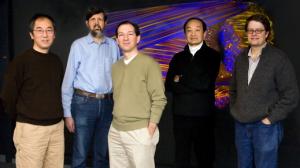28 million hours of supercomputing time for fusion
28 Jan 2011
-
Patti Wieser, PPPL
From left are PPPL scientists Weixing Wang, David Mikkelsen, Stephane Ethier, William Tang, and Greg Hammett with a plasma turbulence simulation in the background. Not pictured is WW Lee.
Scientists seeking to harness fusion energy—a clean, potentially-limitless energy source based on the same reaction that powers our Sun—need to better understand how hot gases called plasmas behave inside fusion reactors. Today's supercomputers may help bring scientists a step closer to that knowledge. To support this effort, the US Department of Energy is awarding 28 million processor hours on its advanced supercomputers to two projects headed by scientists at the DOE Princeton Plasma Physics Laboratory (PPPL).
The allocations are part of the largest-ever awards of the Department's supercomputing time, announced 30 November by Energy Secretary Steven Chu. "The Department of Energy's supercomputers provide an enormous competitive advantage for the United States," said Secretary Chu."This is a great example of how investments in innovation can help lead the way to new industries, new jobs, and new opportunities for America to succeed in the global marketplace."
Fifty-seven innovative research projects, chosen on a competitive basis, will use computer simulations to perform virtual experiments that in most cases would be impossible or impractical in the natural world at this time. Utilizing two world-leading supercomputers with a computational capacity roughly equal to 135,000 quad-core laptops, the research projects could, for example, help in understanding fusion plasma behaviour, speed the development of more efficient solar cells, improvements in biofuel production, or more effective medications to help slow the progression of Parkinson's disease.
PPPL's Weixing Wang has been awarded 20 million supercomputing hours on the Jaguar at the DOE Oak Ridge National Laboratory in Tennessee and PPPL's William Tang has been awarded 8 million supercomputing hours on the Intrepid at the DOE Argonne National Laboratory in Illinois. Four additional PPPL scientists—Stephane Ethier, Greg Hammett, Wei-Li Lee, and David Mikkelsen—are involved in PPPL and DOE Lawrence Livermore National Laboratory projects receiving awards. The researchers will be using the time for fusion energy-related research regarding simulations of plasma turbulence at small and large scales. Plasma is a hot gas of charged particles and the fuel for fusion energy production. It makes up most of the visible universe, comprising all the stars in the cosmos.
"The application of modern computation to the grand challenge of understanding turbulence in fusion plasmas offers potential for breakthroughs in our ability to control turbulence. These projects represent the leading edge of this fertile and crucial area," said PPPL Director Stewart Prager.
Wang's INCITE simulation studies at Oak Ridge will focus on acquiring improved understanding of how plasma flows are generated and to develop predictive capability for plasma rotation in ITER burning plasmas. ITER, currently under construction in the south of France, is a large international fusion experiment with the goal of producing a burning fusion plasma. The INCITE simulation studies led by Tang (with Ethier as co-principal investigator) at Argonne will focus on the key question of how turbulent transport properties change as we move from current-sized tokamaks to ITER. Applications codes, such as those used in this project, have demonstrated excellent scaling and are particularly relevant for "scientific discovery" in that the problem size (and associated physics complexity) can readily increase with the number of processors available on the most powerful modern supercomputers.
The Department is awarding time on two of the world's fastest and most powerful supercomputers—the Cray XT5 ("Jaguar") at Oak Ridge and the IBM Blue Gene/P ("Intrepid") at Argonne. Jaguar's computational capacity is roughly equivalent to 109,000 laptops all working together to solve the same problem. Intrepid is roughly equivalent to 26,000 laptops.
The INCITE awards include nearly 1.7 billion processor hours on the Department of Energy's advanced supercomputers—the largest total ever—reflecting both the growing sophistication of the field of computer modelling and simulation and the rapid expansion of supercomputing capabilities at DOE National Laboratories in recent years.
Awarded under the Department's Innovative and Novel Computational Impact on Theory and Experiment (INCITE) program, many of the new and continuing INCITE projects aim to further renewable energy solutions and understand of the environmental impacts of energy use. The program, open to all scientists, is supported by the Department's Office of Science and managed by the DOE Leadership Computing Facilities at the Department's Argonne and Oak Ridge National Laboratories, which host some of the world's fastest supercomputers.


